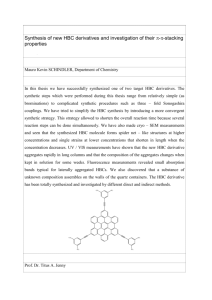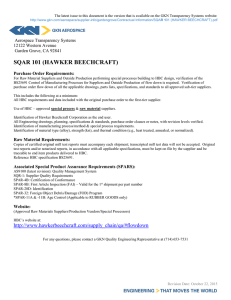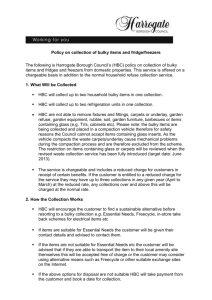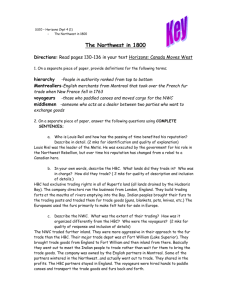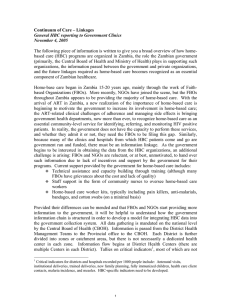Project Proposal Draft Background
advertisement
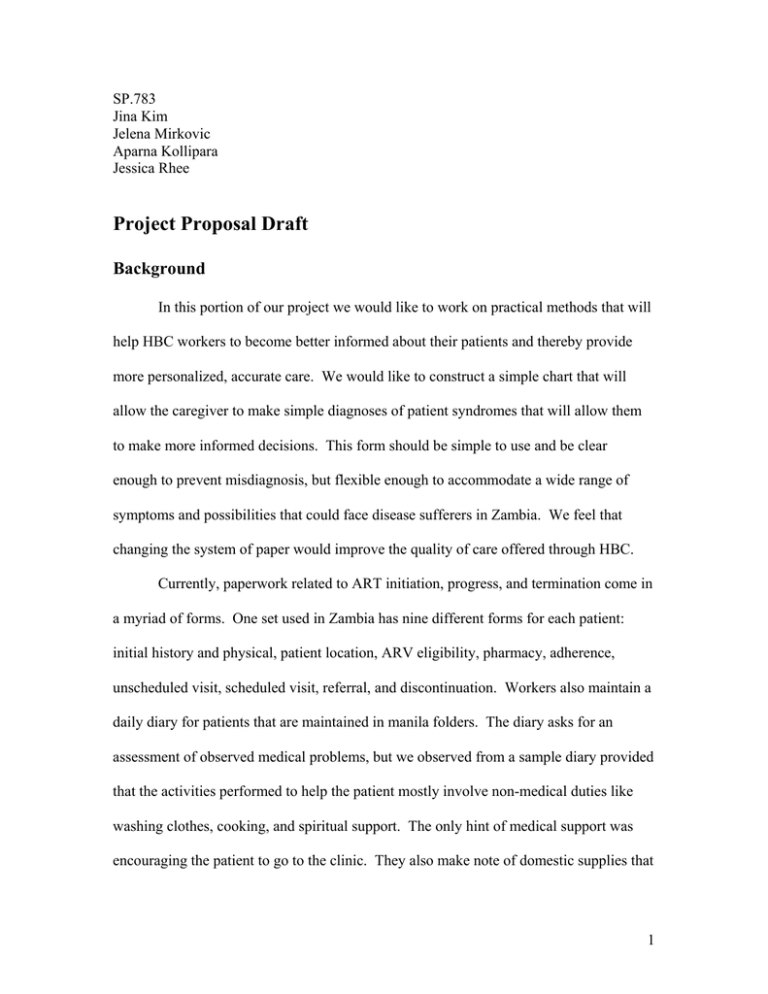
SP.783 Jina Kim Jelena Mirkovic Aparna Kollipara Jessica Rhee Project Proposal Draft Background In this portion of our project we would like to work on practical methods that will help HBC workers to become better informed about their patients and thereby provide more personalized, accurate care. We would like to construct a simple chart that will allow the caregiver to make simple diagnoses of patient syndromes that will allow them to make more informed decisions. This form should be simple to use and be clear enough to prevent misdiagnosis, but flexible enough to accommodate a wide range of symptoms and possibilities that could face disease sufferers in Zambia. We feel that changing the system of paper would improve the quality of care offered through HBC. Currently, paperwork related to ART initiation, progress, and termination come in a myriad of forms. One set used in Zambia has nine different forms for each patient: initial history and physical, patient location, ARV eligibility, pharmacy, adherence, unscheduled visit, scheduled visit, referral, and discontinuation. Workers also maintain a daily diary for patients that are maintained in manila folders. The diary asks for an assessment of observed medical problems, but we observed from a sample diary provided that the activities performed to help the patient mostly involve non-medical duties like washing clothes, cooking, and spiritual support. The only hint of medical support was encouraging the patient to go to the clinic. They also make note of domestic supplies that 1 are given to the patient for regular livelihood. Although HBC workers are minimally trained volunteers, we believe that they can be more integrated in the continuing medical care of a patient if their role is approached differently. None of these forms provide a space where the home-based care worker would be entrusted to note a patient’s symptoms and make simple diagnosis. The care provider, who probably observes the patient most often, only notes problems; presumably, diagnosis is ultimately left up to the physicians who only occasionally see the patient. For example, if a worker observes certain symptoms simultaneously in a patient, like muscle weakness, vomiting, diarrhea, and nausea, he or she should know that they are the signs of lactic acidosis and immediately refer the patient to a doctor. The new paper form that we propose would allow for the provider to realize trends by looking at the overall progression of patient health over a week, month, or multiple months. We believe that incorporating diagnosis into the forms would help care providers understand how to better assist their patients medically and motivate them fill out paperwork accurately. In order to make simple yet effective diagnosis for common conditions and indicators or disease, we found it necessary to identify the most common issues facing Zambians today. Due to the different health concerns facing Zambians, it was important to do research on what the most common health issues were for them. To date, the most common and significant indicators of disease are: 1) Body mass index (BMI) which is height * weight If the HBC worker finds it easier just to record weight, this is also useful. 2) Diarrhea and vomiting #/times per day 2 3) Oral ulcers 4) Oral thrush: fungal infection of the mouth which causes a burning sensation in the mouth and throat Symptoms:White, cream-coloured, or yellow spots in the mouth 5)Persistent headache Can be a symptom of meningitis 6) Loss of appetite 7) Persistent cough, chest pain, and shortness of breath These are symptoms of a respiratory infection (e.g. TB, pneumonia) 8) Lethargy 9) Lactic acidosis is a serious problem, but is very difficult to detect at the HBC level. Lab testing is required to determine whether the patient has lactic acidosis. A simple chart measuring these symptoms in patients would aid HBC workers and healthcare providers to make a more accurate assessment of the patient’s health status and provide better overall care. The goal of our project is to help HBC workers caring for ART patients to not only participate in providing basic care and pill counting, but to also make simple diagnosis. The idea is that the access to patient history will help an HBC worker to evaluate patient progress, and recognize problems and emergency situations. The patient history might be represented by a simple chart and might include the start date of ART, adherence so far, progress (most likely in terms of weight gain over a period of time), history of side effects, and history of opportunistic infections. The HBC worker could have specific weight-gain check points as part of their patient evaluation. If the course of patient weight gain is not what is expected the HBC worker could recognize the problem and refer the patient to higher authorities. Another important area to focus on 3 would be a diagnosis of lactic acidosis. ART patients commonly experience mild side effects such as nausea and diarrhea, but not uncommonly they may develop a life threatening condition, lactic acidosis. This severe side effect is characterized by nausea and diarrhea, but also includes abdominal pain, muscle weakness, rapid breathing and rapid heart rate. If this condition is not recognized and treated, it can be fatal. Besides providing a starting point to lead to better healthcare on an individual basis, there is another benefit to collecting data from patients at the HBC level. Health data is a necessary to build viable and accurate epidemiological understanding of disease trends and demographic information about sufferers. Understanding of what is happening on the ground is essential to construct effective and reasonable policies and plans that will influence how healthcare is managed and provided on a larger scale. Most of the data that is collected in Zambia specifically for use in epidemiological studies is funded by the government through the Zambian Ministry of Health, which uses the National Health Accounts methodology to track health spending and statistics from major hospitals in Zambia. Although this data and methodology have their benefits, relying only on data from major hospitals neglects to take into consideration the many patients who do not rely on hospital care for their illnesses. The NGOs and smaller-scale private organizations that are responsible for HBC delivery and running private clinics probably collect data in the form of completed surveys and patient charts, but the information from these sources is not regularly incorporated into government studies. Also compounding the difficulty in using the data collected from these smaller sources is the fact that methodology and the information gathered may be quite different depending on the particular focus of the group and differences in the paperwork used. Constructing a 4 uniform chart that could be used nationwide would make it easier for data to be integrated and managed on a national scale. Potential Schematic of Proposed Form Ideally, HBC community workers that provide care to ART patients would record and pass on information over a period of time about: 1) adherence 2) symptoms related to drug side effects, and 3) symptoms related to opportunistic infections and AIDS related malignancies. Adherence Adherence is a major component of the successful ART. The information about how well the patient is keeping up with their medication is important. The success of ART therapy could be evaluated quantitatively by recording the change in patient’s weight or body mass index (BMI) over time. Side effects Majority of HIV Antiretroviral drugs, non-nucleoside and nucleoside reverse transcriptase inhibitors, and especially protease inhibitors may produce a range of serious side effects. Some common side effects are: neuropathy (DDC, D4T), pancreatitis (DDI, D4T), elevated triglycerides (Retonavir, Loprinavir), Lipodystrophy (fat redistribution) (Indinavir, D4T), anemia (AZT), irreversible allergic reaction (abacavir), lymphocyte toxicity (AZT), myopathy (AZT), insulin resistance (protease inhibitors), and lactic acidosis (nucleotides- D4T and AZT). The important health indicators to be incorporated into the HBC chart would be the clinical symptoms of ARV toxicity specific to drugs used in HBC patient therapy. For example, if the drug used in treatment is DDC or D4T, it is suspected that the patient may develop peripheral neuropathies, which would manifest in the progressive loss of both motor and sensory function. If AZT is part of the therapy, it is suspected that patient might develop a serious side effect, lactic acidosis, which clinically presents with diarrhea, vomiting, shortness of breath, and rapid heart rate and will lead to death if not properly taken care off. Either graphical or written representation of these symptoms should be incorporated into the chart. Opportunistic Infections and AIDS related malignancies The goal of antiretroviral therapy is to boost the patient’s immunity which suffers severely due to depletion of the CD4+ T cells, white blood cells that orchestrate the immune response. However, if the therapy fails, either due to adherence problems, or to 5 development of drug resistance, the patient becomes severely immunocompromized and is prone to opportunistic infections and AIDS related malignancies. Once again, either graphical (iconic or photograph) or written representation of the symptoms associated with major opportunistic infections should be incorporated into the chart. The major AIDS defining opportunistic infections and associated symptoms: Pneumocystitis Carinii Pneumonia- persistent fever, night sweats, dry cough, shortness of breath CMV Retinitis- blurred vision or loss of vision Mycobacterium avium complex infections- persistent fever, night sweats, dry cough, shortness of breath Cryptococcal meningitis- persistent headache, stiff neck, confusion Genital and Oral Herpes infection- persistence for 30 days Candida infection- oral and esophageal thrush and difficulty swallowing Herpes Zoster (shingles)- painful, blistering rash The major AIDS defining malignancies Kaposi’s sarcoma- purple-red skin lesions on legs and trunk The photographs of important lesions might be included for identifications. The example is the photo of Herpes Zoster infection and oral thrush. Two photos removed for copyright reasons. Herpes Zoster infection and Oral Thrush, from A.D.A.M (http://www.adam.com/index.html) To summarize: Health indicators Adherence: weight, or body mass index Side effects: clinical symptoms of ARV toxicity specific to drugs used in therapy for a patient (i.e diarrhea, vomiting, shortness of breath, rapid heart rate associated with lactic acidosis) Opportunistic infections: clinical symptoms of major opportunistic infections 6 Questions Proposed for Target HBC General HBC Infrastructure: Do HBC organizations hold the HBC workers accountable for their work? Is there a mechanism for supervision in place to ensure regular patient visits? Can we set up a system in which 1) doctors at a given hospital or health care center choose the patients, 2) HBC workers make regular visits to these patients, 3) HBC workers record the patients’ symptoms, and 4) the completed forms are sent back to the doctors? Would such a system work? If not, why not? How and where is current HBC paperwork filed? How many different papers are currently filled out for all different levels of healthcare? What is the turnover rate for HBC workers? Is there any mechanism for feedback to be collected from the patients about HBC workers/healthcare professionals? How much room is there in the system for providing personalized, individually tailored care? What is the level of literacy of HBC workers? Worker-Patient Relations: How are HBC workers assigned to patients? Do doctors or HBC organizations assign them? How are the patients chosen? Is the selection done at random? Or is it based on their health condition/need? How many patients are assigned to a HBC worker? How much time does a HBC worker spend with each patient? How much choice does the patient have in selecting the HBC worker he/she works with? Doctor-Worker Relations: Do doctors currently use—or at least see—any paperwork that HBC workers fill out? What is the current ratio of doctors-to-HBC workers? 7 Would doctors find patient information completed by HBC workers useful in diagnosis? Would it be possible for individual HBC workers to be assigned to a doctor to work with? HBC Worker Training: How much medically related training do the HBC workers receive? Would there be any funding and/or human capacity available to train HBC workers on how to complete the forms? 8 MIT OpenCourseWare http://ocw.mit.edu EC.S11 Engineering Capacity in Community-Based Healthcare Fall 2005 For information about citing these materials or our Terms of Use, visit: http://ocw.mit.edu/terms.

